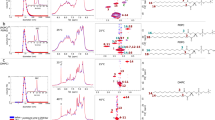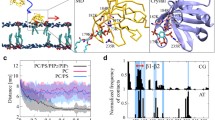Abstract
Protein–lipid interactions dynamics through a three-variable reaction–diffusion model in the living cell are explored. It is proven that the dynamics of such a system is governed by a two-dimensional cubic complex Ginzburg–Landau equation. Linear stability analysis is carried out through modulational instability. It appears that both rate constant of lipid association of unphosphorylated proteins and the diffusion coefficient of proteins on membrane impact the zone of instability and the amplitude of the growth rate. The \((G'/G)\)-expansion method is used to construct analytical spiral and periodic solutions. These structures are robust and propagate for large values of the diffusion coefficient of proteins on membrane during protein–lipid interactions.













Similar content being viewed by others
Data Availability Statement
No Data associated in the manuscript.
References
A.W. Smith, Biochimica et Biophysica Acta 1818, 172–177 (2012)
J.C. Castillo-Sanchez, A. Cruz, J. Pérez-Gil, Arch. Biochem. Biophys. 703, 108850 (2021)
M.R. MacRae, D. Puvanendran, M.A.B. Haase, N. Coudray, L. Kolich, C. Lam, M. Baek, G. Bhabha, D.C. Ekiert, J. Biol. Chem. 299, 104744 (2023)
P.V. Escriba, J.M. Gonzalez-Ros, F.M. Goni, P.K.J. Kinnunen, L. Vigh, L. Sanchez-Magraner et al., J. Cell. Mol. Med. 12, 829 (2008)
W. Dowhan, M. Bogdanov, Annu. Rev. Biochem. 78, 515 (2009)
A.G. Lee, Biochem. Soc. Trans. 39, 761–766 (2011)
Gu. Ruo-Xu, Bert L. de Groot, Nat. Commun. 11, 2162 (2020)
S.L. Veatch, S.L. Keller, Phys. Rev. Lett. 89, 268101 (2002)
H.M. McConnell, M. Vrljic, Annu. Rev. Biophys. Biomol. Struct. 32, 469 (2003)
K. John, M. Bär, PRL 95, 198101 (2005)
T.S. Braun, J. Stehle, S. Kacprzak, P. Carl, P. Höfer, V. Subramaniam, M. Drescher, J. Phys. Chem. Lett. 12, 2471–2475 (2021)
P.J. Blackshear, J. Biol. Chem. 268, 1501 (1993)
S. McLaughlin et al., Annu. Rev. Biophys. Biomol. Struct. 31, 151 (2002)
A.W. Smith, Biochimica et Biophysica Acta 1818, 172–177 (2012)
L. Jiang, Z. Xiong, Y. Song, Y. Lu, Y. Chen, J.S. Schultz, J. Li, J. Liao, Sci. Rep. 9, 2050 (2019)
B.I. Sejdiu, D.P. Tieleman, Biophys. J. 118, 1887–1900 (2020)
J.C. Castillo-Sanchez, A. Cruz, J. Pérez-Gil, Arch. Biochem. Biophys. 703, 108850 (2021)
R.Y. Ondoua, C.B. Tabi, H.P. Ekobena Fouda, A. Mohamadou, T.C. Kofané, Eur. Phys. J. B 85, 318 (2012)
C.B. Tabi, J.C. Mimshe, H.P. Ekobena Fouda, A. Mohamadou, T.C. Kofané, Eur. Phys. J. B 86, 374 (2013)
J.C. Mimshe Fewu, C.B. Tabi, H. Edongue, H.P. Ekobena Fouda, A. Mohamadou, T.C. Kofane, Phys. Scr. 87, 025801 (2013)
C.B. Tabi, R.Y. Ondoua, H.P. Ekobena Fouda, T.C. Kofané, Phys. Lett. A 380, 2374 (2016)
R.Y. Ondoua, J.C. Mimshe Fewu, D. Belobo Belobo, C.B. Tabi, H.P. Ekobena Fouda, Eur. Phys. J. Plus 136, 274 (2021)
P. Otlaadisa, C.B. Tabi, T.C. Kofané, Phys. Rev. E 103, 052206 (2021)
D. Zanga, S. Fewo, C.B. Tabi, T.C. Kofané, Commun. Nonlinear Sci. Numer. Simul. 80, 104993 (2020)
C.B. Tabi, S. Veni, T.C. Kofané, Phys. Lett. A 442, 128192 (2022)
K. Ndebele, C.B. Tabi, T.C. Kofané, J. Opt. Soc. Am. B 37, A214 (2020)
K. Ndebele, C.B. Tabi, C. Tiofack Latchio, T.C. Kofané, Phys. Rev. E 104, 044208 (2021)
D. Zanga, S. Fewo, C.B. Tabi, T.C. Kofané, Phys. Rev. A 105, 023502 (2022)
C. Panguetna, C.B. Tabi, T.C. Kofané, Phys. Plasmas 24, 092114 (2017)
C. Panguetna, C.B. Tabi, T.C. Kofané, Commun. Nonlinear Sci. Numer. Simul. 55, 326 (2018)
C. Bansi Kamdem, C.B. Tabi, A. Mohamadou, Chaos Solit Fract 109, 170 (2018)
C.B. Tabi, A.S. Etémé, A. Mohamadou, T.C. Kofané, Waves Rand Comp Media 31, 1028 (2021)
Kuramoto Yoshiki, Chem. Oscil. (Springer-verlag, Berlin, Waves and Turbulence., 1984)
A.S. Eteme, C.B. Tabi, A. Mohamadou, Chaos Solitons Fractals 104, 813–826 (2017)
N.R. Zaoro, C.B. Tabi, A.S. Eteme, T.C. Kofané, Phys. Lett. A 384, 126133 (2020)
P.G. Legoya, A.S. Etémé, C.B. Tabi, A. Mohamadou, T.C. Kofané, Chaos Solitons Fractals 164, 112599 (2022)
Chenceline Fouedji, Armand Sylvin Etémé, Conrad Bertrand Tabi and Henri Paul Ekobena Fouda. Eur. Phys. J. Plus 138, 987 (2023)
M. J. Ablowitz, P. A. Clarkson, Cambridge University Press (1991)
C.T. Yan, Phys. Lett. A 224, 77 (1996)
C.B. Tabi, T.G. Motsumi, C.D.K. Bansi, A. Mohamadou, Commun. Nonlinear Sci. Numer. Simul. 49, 1 (2017)
M.L. Wang, Y.B. Zhou, Phys. Lett. A 318, 84 (2003)
R. Hirota, Cambridge University Press (2004)
W. Liu, Y. Weitian, C. Yang, M. Liu, Y. Zhang, M. Lei, Nonlinear Dyn. 89, 2933–2939 (2017)
W. Domgno Kuipou, A. Mohamadou, E. Kengne (2021) Chaos Solitons Fractals, 152:111321
M.L. Wang, X.Z. Li, J.L. Zhang, Phys. Lett. A 372, 417 (2008)
G.R. Kol, C.B. Tabi, Phys. Scr. 83, 045803 (2011)
C.B. Tabi, A.S. Eteme, A. Mohamadou, T.C. Kofané, Waves Rand Comp Media 31, 1028 (2019)
A. Atri, J. Amundson, D. Clapham et al., Biophys. J. 65, 1727 (1993)
S. Girard, A. Luckhoff, J. Lechleiter et al., Biophys. J. 61, 509 (1992)
A.R. Battle, P. Ridone, N. Bavi, Y. Nakayama, Y.A. Nikolaev, B. Martina, Biochimica et Biophysica Acta 1848, 1744–1756 (2015)
Theresa S. Braun, Juliane Stehle, Sylwia Kacprzak, Patrick Carl, Peter Höfer, Vinod Subramaniam, Malte Drescher, J. Phys. Chem. Lett. 12, 2471–2475 (2021)
Acknowledgements
The authors would like to express their gratitude the Professor Conrad Bertrand Tabi from Botswana International University of Science and Technology (BIUST), Botswana, for his significant contribution during the development of this work.
Author information
Authors and Affiliations
Corresponding author
Appendices
Appendix A: Calculation details of generating the 2D-CGL equation Eq. (4)
Equation (1) becomes:
We linearize the set of equations (A1) and obtain:
where \(\alpha _{0}=\frac{1}{k_{m}}\); \(\alpha _{1}=-(k_{de}+\frac{k_{ki}}{k_m})\); \(\alpha _{2}=k_{ad}\); \(\alpha _{3}=\frac{k_{ki}-k_{de}}{k_{m}}\); \(\alpha _{4}=k_{ad}(-1+\frac{1}{k_{m}})\); \(\alpha _5=-\frac{k_{ad}}{k_m}\); \(\alpha _6=\frac{D_m}{k_m}\); \(\beta _{1}=k_{de}\); \(\beta _{2}=k_{ph}\); \(\gamma _{1}=\frac{k_{ki}}{k_m}\); \(\gamma _{2}=-\frac{k_{ph}}{k_m}\); \(\gamma _{3}=\frac{D_c}{k_m}\). We derive the first equation of (A2) with respect to t, with the used of the second equation of (A2) and obtain
where the expressions of \(a_i\), \(b_i\), \(d_i\), \(e_i\),\(g_i\), \(h_i\) and \(\Omega _i\),\(i=0,1,2,3,4\) are given by:
which depend on the parameters of the model. From the third equation of (A2) and Eq. (A3), we have
Here, we have the real-valued conditions:
The asterisk denoting complex conjugations. The insertion of Eq. (A5) into the difference-differential Eqs. (A4) at the different orders of \((\epsilon ^n, A^l\) \(n=1,2,3)\), we obtain:
− order \((\epsilon ^1,A^0)\)
− order \((\epsilon ^1,A^1)\)
and we consider \(m_1^{(1)}=\phi \)
− order \((\epsilon ^2, A^0)\)
with,
− order \((\epsilon ^2, A^2)\)
where
Appendix B: Calculation details of implementation of \((G'/G)\)-expansion method to the two-dimensional cubic complex Ginzburg–Landau equation
Inserting solution Eq. (20) into Eq. (4) and separating the real and imaginary parts lead to
We further set
where \(\mu _0\) is another constant to be determined later. Substituting (B2) into (B1), one arrives to the system
The factors in the trial solution Eq.(16) can be found by balancing the highest order derivative term \((F')^2\) and the highest nonlinear term \((F^4)\) appearing in (B3). In fact, the weight of the derivative is \(2(s+1)\) and that of the nonlinear term is 4s. Equating the two weights, i.e. \(2(s+1)=4s\) leads to the result \(s=1\), for which we get
We substitute Eq. (B4) into Eqs. (B3) and, after eliminating the denominator and collecting all terms with the same order of \(\left( G'(X)/G(X)\right) \) together, the left-hand sides of Eqs. (B3) are converted into two polynomials in \(\left( G'(X)/G(X)\right) \). Setting the coefficients of these polynomials to zero, we derive a set of algebraic equations for \(u_1\), \(u_2\), \(v_1\), \(v_2\), \(\omega _1\), \(\omega _2\), \(\mu _0\), \(\Lambda \), \(\Upsilon \), \(q_0\), \(q_1\) and \(q_{-1}\). The resolution using the computer algebra software MAPLE leads to solutions given in Eq. (22).
Rights and permissions
Springer Nature or its licensor (e.g. a society or other partner) holds exclusive rights to this article under a publishing agreement with the author(s) or other rightsholder(s); author self-archiving of the accepted manuscript version of this article is solely governed by the terms of such publishing agreement and applicable law.
About this article
Cite this article
Mebara, E.R.A., Ondoua, R.Y. & Fouda, H.P.E. Dynamics of protein–lipid interactions in a three-variable reaction–diffusion model of myristoyl-electrostatic cycle in living cell. Eur. Phys. J. Plus 138, 1158 (2023). https://doi.org/10.1140/epjp/s13360-023-04792-7
Received:
Accepted:
Published:
DOI: https://doi.org/10.1140/epjp/s13360-023-04792-7




